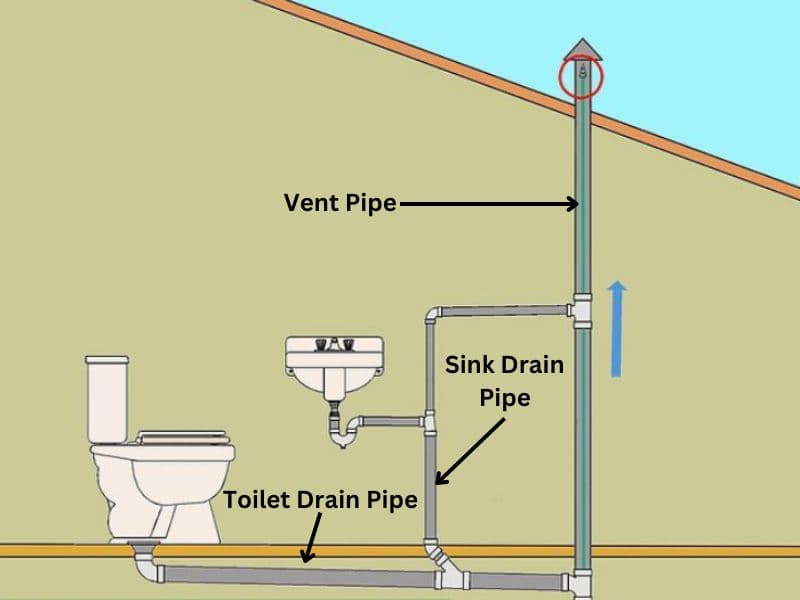A drain vent pipe is a critical part of your home drainage system as it helps in regulating the airflow within the entire drainage. The vent pipe prevents foul odor from the sewer from dominating your home through proper air circulation. It also ensures that the waste keeps flowing. When it clogs, it’s a big mess.
A clogged drain vent pipe is identified with various symptoms, including water taking longer to drain, dry and empty toilet tanks, foul toil smells, and a gurgling sound when you flush the toilet. Unclog a drain vent pipe by going to the roof and using the drain snake in the pipe.
You can tell from the role it plays that it can be disastrous when the vent gets clogged. I explore the symptoms of a clogged drain vent pipe and how you can unclog it in the sections below.

Symptoms of a clogged drain vent pipe
Here are the symptoms of a clogged drain vent pipe that you need to look out for:
1. Foul Smell
The sewer gasses escape the drainage system through the vent pipe, so when it’s clogged, they find other ways to escape to your home. For example, the gasses could escape through the toilet or find leakages in the pipes.
Clogging in the vent pipe means that the drainage system has reduced air pressure, which translates to the complete emptying of the pipes, including the p-traps.
If the P-trap dries out, it won’t be able to contain the gasses flowing through the pipes, leading the gasses to find an escape route in the toilet. The result is a foul smell that fills your home.
Mostly, the smell is a combination of gasses that include ammonia, methane, and hydrogen sulfide.
2. Gurgling Sounds
The drain vent pipe could be clogged if you notice the “glug glug” sounds on your toilet.
The gurgling sound comes from the difference between the air supply and the water in the pipes. A clogged vent is limited in air supply, meaning the waste leaves behind a vacuum. As such, it takes longer for the drain pipes to pass the waste, creating the gurgling sounds.
A blocked vent pipe restricts the air from passing through. As a result of that, the air looks for an escape route. Mostly it’ll be the toilet, and if there’s water in the trap, it escapes through it, leaving behind a gurgling sound.
3. Slow Draining
If you notice the drain pipes taking too long to drain away, it could indicate a blocked vent. Air gets into the system through the vent, and the waste is pushed out of the drain through pressure.
With the vent blocked, it may not be possible for the system to push the water at the same rate. As a result, you will notice the system taking longer than usual to dispense the waste.
For the entire drainage system to function properly at the correct speed, there needs to be a balance of the air on the inside and outside. If the vent pipe is blocked, pressure remains on the inside, leading to slow draining.
Before you rule out other possibilities that could be blocking the drainage and slowing the process, check out the vent pipe to dismiss any possibilities of a blockage.
4. Poorly Flushing Toilet
You may not take the time to observe when your flushing system starts failing until it’s too late when there is a delay in the flushing process.
When the vent pipe is clogged, your toilet flushing system will malfunction due to insufficient air to hold the flushing water in the correct place in the correct amounts.
A blocked drain vent pipe will lead to empty tanks in your flushing system. Since there is no air pressure to allow the water to rest in the tank, it will keep flowing through the system. This means the water will keep flowing through the pipes, leaving the tank empty.
If you had a fully functional toilet system, then all of a sudden it fails because there isn’t water in the tank, then that’s a clear indication your vent pipe could be blocked.
A poorly flushing toilet, however, can be due to cold weather, which can cause low water pressure and affect the toilet and shower.
How to unclog a vent pipe
Once you identify these symptoms and verify that the vent pipe is clogged, you need to act swiftly to unclog it before the damage is too extensive. Unclogging a toilet vent also helps increase the toilet flush power, among other benefits.
Prepare well for the exercise before you embark on the procedure. Bring a ladder with you, and ensure it’s long enough to help you access the roof.
Have somebody else left in the toilet because you don’t want to keep climbing and coming down to verify if you have fully unclogged it.
Further, ensure you have the following items:
- Snake (plumber’s auger)
- Garden hose
- Torch
- Screwdriver
To unclog the vent pipe, follow these steps:
1. Get to the Roof
Using your stabilized ladder, get to the roof and ensure you are comfortable for your safety. Give your safety a priority; you could even consider postponing the entire exercise if the weather is unfavorable. Alternatively, have someone steady the ladder on the ground as you climb up the roof.
Once well-grounded, use the screwdriver to remove the cap if your vent has one. In most cases, the cap is held in place by two screws. So, loosen it. You could even unscrew only one side to save time.
Using the torch, light up and check to see the level of the debris. This is important as it will guide you on the height of the hose or snake you’ll need to push through.
Ask your assistance in the toilet to flush as you listen on the vent or place your hand over it. If you fail to feel a pull or suction on your hand, the debris is further down the vent pipe.
2. Dip a Plumber’s Snake into the Vent
On the one hand, dip the snake down to the pipe until you feel the debris blocking the pipe and remove it. You can use a commercial or DIY toilet snake for this task.
Continue moving the snake around the pipe to clear all debris. If the snake isn’t entirely removing the debris, use the garden hose to perfect the exercise.
3. Flush the Toilet
Before you come down, have your assistant in the toilet flush again as you place your hand on the opening of the vent pipe. If you can feel the suction strongly, congratulations, you have successfully unclogged the vent pipe.
Screw the cap back and carefully get down. If the vent pipe fails to unclog, you need to engage a professional to handle the exercise.
Is a clogged vent pipe dangerous?
Yes, clogged vent pipes are dangerous as they result in toxic gasses filling up your house and could also result in water backups.
Since the clogged pipe doesn’t allow airflow, the water along the pipes will remain stagnant. When this happens for a long time, the water fills up the pipes and starts to flow back, looking for an exit through the drains.
Common gasses found in the sewer won’t be able to escape to the outside environment, and that will lead to the toxic gasses escaping through the next easy route, which is the toilet. Once this happens, your house will smell as bad as rotten eggs due to sewer gasses such as ammonia, methane, and hydrogen sulfide.
Other plumbing stack vent problems
You don’t want to run the risk of a stack vent, as the problems that come with it are devastating. In addition to the toxic gasses and water flowing back up, a stack vent could lead to:
- Waterborne diseases will be a likely result, given that the water backup could harbor bacteria.
- Damage to the plumbing system as the pipes are heavy from the stagnant water that won’t flow through.
- The increased cost of maintenance when you are forced to invite a professional to handle the clog
- Your loved ones could be exposed to methane and hydrogen sulfide poisoning.
A clogged vent can easily lead to an unlivable home if you’re not careful.
Conclusion
A clogged vent pipe can be disastrous to you and your loved ones. The moment you notice any of the symptoms is the moment you act. Failure to act swiftly could affect the functioning of your sewer line, and it could get worse if the system is interconnected with that of your neighbors, as the odor will get to them too.
